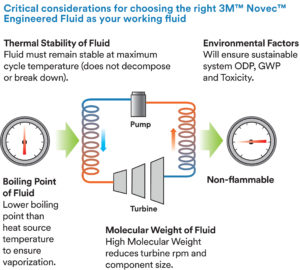Acota has been appointed the Authorised Distributor for 3M™ Nextel™ Ceramic Fibres and Textiles, for the UK & North Europe.
The simplest way to explain an Organic Rankine Cycle, or ORC, is to say it converts thermal energy into electrical energy. (It’s ‘Organic’ because it uses Organic Chemistry as the working fluid)
There is a growing interest in the use of ORCs to utilise low grade waste heat from geo-thermal, solar, diesel engines or other heat sources to generate useful electrical energy.
It is based on the principle of a liquid being heated which causes it to evaporate – the resulting vapour is then used to turn a turbine, which is connected to a generator which creates electrical energy. The vapour is condensed and is re-routed back to the heat source. In doing this, the ORC improves the overall efficiency of a system through waste heat recovery and produces no emissions.
With increasing fuel demand, rising costs and the need to reduce pollutants, the desire to develop technologies to enable more efficient use of power has never been greater.
ORCs are being investigated for use in a wide variety of processes, from domestic water heaters and industrial and farming processes through to exhaust gases from ovens, furnaces and vehicles.
One of the most important design elements in a low temperature ORC is the choice of the working fluid to absorb the heat from the primary energy source.
Selection of the working fluid in a low temperature ORC is a multi-dimensional problem. Not only does the fluid generally require a lower boiling temperature that water, environmental effects also need to be considered. Refrigerants and hydrocarbons are two which are commonly used; however, hydrocarbons have flammability issues and there are environmental concerns with many refrigerants.
In general, the thermal efficiency of a Rankine cycle improves as the difference between the heat source and sink temperatures increases. However, the actual performance of any given system will also depend on the thermodynamic properties of the chosen working fluid. The thermophysical properties of the fluid will have implications on component sizing, cost and overall system design.

The fluid should offer long-term thermal stability at the expected maximum cycle temperature. It should also be non-corrosive, to protect the integrity of heat exchangers, seals and other system components.
The fluid should be non-flammable and low in toxicity.
Environmental regulations are becoming more stringent and, as such, factors such as low global warming potential and a short atmospheric lifetime will help ensure the viability of a fluid, in the present day and at the time of decommissioning.
There are two fluids from 3M™ which are well suited for use in Organic Rankine Cycles (ORC):
They are part of the 3M Novec Engineered Fluids range and offer proven heat transfer performance, with properties that include:
Novec Fluids are compatible with a wide variety of materials used in ORC equipment. Most of the materials commonly considered “hard” plastics will perform well with Novec fluids. In addition, all metals, hard polymers and variety of inexpensive elastomers can be used. Elastomers should be limited to those that are not heavily plasticized. We can assist you with recommendations and testing on specific compounds.